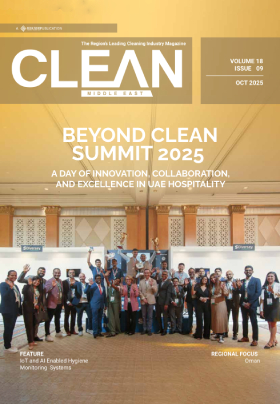
Healthcare associated infections (HCAI’s) are responsible for considerable burdens of morbidity and mortality globally. The hospital environment, particularly the near-patient environment is a recognised reservoir and vector of nosocomial pathogens, elevating the risk for cross-contamination between hand contact surfaces within the patient environment and the patient themselves.
Research studies have identified the critical control points and implemented enhanced manual cleaning and disinfection methods as well as automated area decontamination technologies. All to varying degrees of success and failure to achieve consistent reliable outcomes.
A positive impact of the pandemic on environmental support services is refocusing attention on the patient environment and acknowledging the importance of the role of cleaning and disinfection: - training, methodology, materials, frequency and re-evaluation of traditional, current and emerging technologies.
Restoring environmental balance and controls
The environmental response to SARS CoV2 resulted in increased use of chemicals which have resulted in both damage to surfaces and an accumulation of residue including biofilm. This biofilm may host several pathogens which can remain viable for days, weeks or months unless physically removed. This residue also acts as an inhibitor to chemical disinfection efficacy which means current cleaning and disinfection practices can continue ineffectively, inadvertently failing to mitigate the risk to patient safety.
Research has evidenced the viability of antimicrobial resistant pathogens contained within dry biofilms recovered from hand contact surfaces within the critical care environment, including MRSA, Acinetobacter spp, VRE, CRKP and Clostridium difficile spores.
Biofilm formation can be problematic for many typical hospital surfaces, with affinity to plastics, surface texture and prior damage to surfaces due to chemical degradation. Surface biofilm in its dry state is invisible, can be extremely problematic to eliminate presenting a significant risk factor and potential cause of infection outbreaks.
Of primary concern is the risk of promotion of antimicrobial resistance through sub-optimal surface disinfection practices. Biofilm provides microbial protection and resistance to traditional synthetic chemical disinfectants. Mechanical action is a key factor in physically removing dry biofilm from surfaces particularly where the surface may not be smooth or damaged.
Water based technologies such as Dry Steam Vapour machines and professional microfibre textiles can provide (deep cleaning) penetration and effective removal of dry biofilm from surfaces. Restoring the surface integrity for ongoing maintenance without the need for harsh chemicals and contributing to a more sustainable approach to surface hygiene in the newly acknowledged title of “Bio-Cleaning”.
Restoration, Protection, Prevention
The physical act of ‘Bio-cleaning’ with mechanical action removes soil, including contamination by micro-organisms, biofilm and residues. The efficiency with which soil and microbes are removed from typical healthcare environment surfaces has been studied utilising microbiological measures to investigate the efficacy of individual and Integrated water-based technologies, including UltraMicrofibre Smart Textiles, Dry Steam Vapour (DSV), Silane based and photocatalytic antimicrobial polymer surface coatings and Stabilised Hypochlorous (HOCL) solutions pH adjusted to provide cleaning and disinfectant solutions.
These four components work synergistically to provide clean, safe surfaces.
Hypochlorous differs from traditional disinfectants in that it is a chemistry which appears in nature and is compatible with human health and the environment. Hypochlorous is a free chlorine produced by electrolysis from water and salt solution.
Hypochlorous has four modes of antimicrobial action, Erosion of the external cell wall, internal perforation of the cell membrane, damaging the DNA and RNA eliminating cell reproduction, denaturing the protein and enzymes disabling cell activity.
Distinct from traditional synthetic disinfectants, hypochlorous does not carry a positive or negative charge enabling rapid penetration through the microbe cell wall and fast acting disinfection immediately on contact. No dwell time required.
Hypochlorous dissipates water with no residue. This is an ideal characteristic for the maintenance of antimicrobial coatings. Residue accumulation will inhibit the efficacy of the antimicrobial coating. Microfibre cloths pre-dosed with hypochlorous solution combine the synergistic action of mechanical removal of soil from the surface and the application of hypochlorous disinfection in a single step. The antimicrobial coating provides protection between cleaning cycles.
This programme has been developed as an integrated approach to environmental hygiene. The “EnviroSmart Technologies” programme has also looked at the environmental sustainability aspects of not only the materials, but also with Standards and the process of deployment.
With the introduction of Standards across the spectrum of performance requirements, users can adhere to strict environmental performance. Microfibre textiles can earn the Nordic Swan certification for mitigation of microplastic pollution into the environment. Microfibre cloths and mops can be tested to cleaning and disinfection standards EN16615, which is the same test for disinfectants applied with mechanical action. Microfibre has a dual action of removal (5 log 99.999% efficiency) tested with water alone. When using electrolysed water (HOCL) the active disinfection activity from the hypochlorous (99.999%) increases the potential to provide an assured level of confidence of both soil removal and virtually total elimination of microbial contamination.
Microfibre textiles are now being made from recycled materials such as coffee grounds and PET water bottles.
Research continues with the evolution of Hypochlorous applications. Given its safety profile of being safe with human contact, techniques of area decontamination can be developed. Hypochlorous can be used within a wipe, sprayed onto a surface, aerosolized as a vapour and has potential with cold plasma technology to be used as a gas for airborne decontamination. Cold Plasma Hypochlorous disinfection represents a paradigm shift in how we may react and proactively respond to infection within the built environment.
 About the author
About the author
Mr. Michael Rollins is an independent consultant specialising in the implementation of healthcare hygiene technology, environmental Infection prevention and integration with patient safety quality improvement initiatives. He is an active member of the Infection Prevention Society UK, Patron of the National Association of Healthcare Cleaning Professionals (AHCP) UK and member of the Education and Training advisory group. Michael is also an Associate Subject Matter Specialist (Environmental Infection Prevention) for Nahdat al Tamayuz, Abu Dhabi, and Environmental Education Excellence Ltd, Training company UK.

.jpg)
.jpg)
 Search
Search.jpg)
